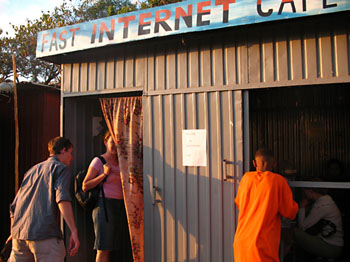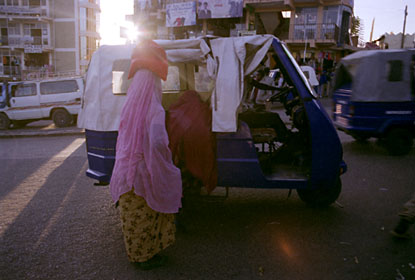Quick Tips & Getting Around
 "Fast Internet" in a roadside shack, Lalibela |
• ATMs are not readily available. There are a couple VISA machines in Addis but Mastercard holders are out of luck. Bring plenty of cash or traveler's checks.
• Internet connections are dial-up in this country! Be patient, or simply give email a rest for a while. Lalibela's connection is especially slow and the fee offensively high.
• Ethiopian food may well be the best in sub-Saharan Africa, and is definitely one of the few unique cuisines in a region that favors nsima/mealie-meal type goo. I personally found the stews and meats were excellent (especially because Ethiopians are not afraid of spice!), but grew tired of injera. No one will protest if you request bread (dabbo) with your meal instead. The Seven Olives hotel's restaurant in Lalibela offered a third option: wheat injera. It's quite tasty, not fermented, with a similar sponginess but none of the clammy dampness of injera.
• Wednesdays and Fridays are "fasting days," but that does not mean people don't eat—they simply don't eat meat. Restaurants that cater toward tourists should still serve meat on those days but you'll occasionally come across some that don't.
 Taxi in Harar |
Ethiopian roads vary in quality, but the dirt roads in most tourist areas are relatively flat. Buses are a great way to experience local flavor, but the size of the country means transport between remote towns can take days.
Tourists wanting to experience local transport on limited time are advised to look for paved routes. Most visitors to the northern historical circuit will choose to bus between Gondar and Bahir Dar (4 hours). The road between Addis and Dire Dawa is paved the full 12-hour drive, if you're up for it! Also extraordinarily beautiful is the short road (supposedly 1 hour but sometimes more like 2) between Dire Dawa and Harar. The Bradt guide claims that buses in Ethiopia don't constantly stop to pick up new passengers but I don't agree.
Flying is much more efficient. As in many developing countries, there is no penalty for one-way flights. Flights to the northern circuit traverse the route Addis - Bahir Dar - Gondar - Lalibela - Axum - Addis, so as a general rule of thumb, if you don't want to backtrack you should visit the towns in that order. However, there are also direct flights from Addis to Gondar, between Bahir Dar and Lalibela, and from Bahir Dar to Addis. Flights are also available from Addis to the east and south, but neither region gets much coverage.
Ethiopian Airlines is known for delays but is reasonably reliable and provides a snack even on 30-minute flights. Reconfirmation necessary the day before a flight, but preference seems to be given to those who pay early rather than simply reserve. The staff is helpful and can re-confirm over email or phone as well.
The historical circuit towns and Harar are small enough to walk around. Harar is plenty chaotic however, so you may want to use a taxi to and from the bus station. Lalibela is surprisingly hilly so visiting the rock-hewn churches might be easier with help of a taxi or horse-drawn carriage. Taxis can also be useful in Bahir Dar if you want to visit the source of the Blue Nile or the Blue Nile Falls—although the former is walkable if you have the time.